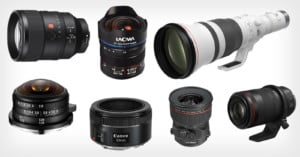
Symmetry in Photography: A Basic Guide for Better Compositions
Wherever you are right now, take a moment to look around. What patterns and shapes do you see? What objects, scenes, buildings, or other designs just look like they “make sense?”

Wherever you are right now, take a moment to look around. What patterns and shapes do you see? What objects, scenes, buildings, or other designs just look like they “make sense?”

Do your photos suck? Feeling discouraged by your photography lately? Not making the progress you expected? The good news is, it’s completely normal — all photographers grow at different rates and hit speed bumps along the way.

I’ve long strived for depth in certain photos. I like a line that begins in the lower corner and heads for the diagonally opposite upper corner.

With the recent excitement surrounding the release of the film Oppenheimer, there have been lengthy discussions about the best way to watch it – mostly because of something called an aspect ratio and the way that it affects the viewing experience. This is a term that is used widely in film, and it’s just as important for photographers to understand.

Many photographers will say that your camera lens is as important (or even more important) than your camera body. All of the light that your camera body captures has to go through some sort of lens, which affects sharpness, distortion, amount of light, perspective, and many other variables.

One of the most exciting things to photograph is a live concert. Rock concerts in particular have an air of electricity about them that you can feel. When you are hired to photograph one you automatically feel like you are a part of that excitement.

If you shoot headshots and/or portraits, clamshell lighting is something you should definitely become familiar with. This versatile and easy-to-create lighting setup produces a very flattering look useful for a variety of portrait situations.

Product photography is a major branch of commercial photography that is ubiquitous in our world, as product photos are used for everything from billboards and print ads to catalogs and store displays. If you'd like to learn how to become a product photographer, you've come to the right place.

Although many photographers approach it in different ways, understanding white balance is a key to getting better at photography. Like other camera settings, it’s possible to have your camera set white balance automatically, but it doesn’t always produce the best results.

Lens flare can appear as spots or streaks of light and color or as a washed-out hazy look in your photographs. Some photographers and filmmakers like to use it creatively, but it usually shows up as an unpleasant surprise that can ruin your picture.

Amazingly, in the age of AI image creation, film photography is not only popular but it's growing again after an initial decline. More and more, people are finding value in timeless, handcrafted imagery.

Producing a decent print is not as easy as you might think. You might get lucky and get a great result the first time. But, more likely, when you start printing your work, you’ll find it might not look as good as you’d hoped. Don’t give up. With a bit of practice and a better understanding of the process, you can quickly improve your printing.

When it was first introduced, many people sharply believed that autofocus would never have a clear place in the photography industry, puns intended. Why have a machine guess where to focus when you can just turn the focusing ring yourself? Today, autofocus systems are among the primary selling points for new camera and lens technology.

Loop lighting is a very common style of portrait lighting that is seen very often in portrait photography. In fact, if you’ve spent much time at all shooting in a studio, you’ve probably employed loop lighting without specifically trying to.

In landscape photography, it is helpful to have three specific lens filters in your camera bag. These are the circular polarizer (CPL) filter, the neutral density (ND) filter, and the graduated neutral density filter (GND).

Photography is a visual art, and as with most art forms, there are no rigid rules or formulas that guarantee a captivating image. However, there are certain key elements that often contribute to an image's impact and appeal.

Printing your photography is a great way to display it, give it as a gift, and experiment with different ways to present your work. One aspect of printing that will inevitably come up is the type of paper that you want to print on -- should you choose glossy or matte?

Food photography is one of the easiest photography disciplines to start out with. You can arrange food however you like. It doesn’t scamper away mid-shoot and doesn’t get tired. It’s also relatively contained and easy to practice.

Aerial photography can give viewers a unique perspective that differs from their everyday visual experience, and therefore can bring novelty to an image.

Zone focusing (ZF) is a great way to pre-set your camera's focus and aperture, then use that setting for multiple shots. Street shooters love it. And it's also great for sports, pets, jumpy kids, parties, or any subjects in motion.

One of the most basic and common terms in the world of photography is the focal length of a lens. In this guide, we will dive down deep into what focal length is and how it works.

An intervalometer is an important tool for photographers that is useful across a range of photography genres and techniques, including timelapses, focus stacking, and long exposures.

We’ve all heard the term "dynamic range" when reading the latest and greatest offerings of camera manufacturers -- "this camera has the highest dynamic range in its category!" We understand that a greater dynamic range is generally a good thing to have.

Photographers use a range of different filters on their camera lenses for different effects and purposes, and one of the most common filters found in a camera bag is the standard UV filter.

If you've ever noticed an unsightly colored fringe or halo on objects in your photographs, you've seen chromatic aberration. It's a common problem in photography and can detract from an otherwise good image. Fortunately, there are ways to minimize or even eliminate it, both before you hit the shutter button and after when editing your picture.

There's more to consider than focal length and price when buying a new lens. Lenses come with an assortment of features such as stabilization and weather sealing, plus issues like distortion and bokeh.

Light painting has become a popular technique in the age of digital photography. If you have always wondered how to do light painting photography yourself, you've come to the right place.

Even though we are firmly ensconced in the digital age when it comes to photography, analog photography has picked up steam in popularity and doesn’t seem to be slowing down.

I think photography educators teach and talk about photography to beginners in an overly complicated way. It’s all concepts, jargon, theories, and numbers. It should be focused on composition and how to take ‘better’ photographs as this is what most beginners join courses to learn.

In the photographic arms race, mirrorless systems are on the rise, having pushed DSLRs into the history books. But, just as film isn’t dead, neither are rangefinders. This seemingly obsolete design remains sharp, fast, and challenging enough to suit even the most confident photographers.

When compared to the other components of the exposure triangle (shutter speed and aperture), ISO appears to be the most intuitive on the surface. It is also the most misunderstood component, and everything from its definition to its usage has been discussed extensively.

There are many types of camera lenses out there, and it can be a bit confusing and even frustrating trying to sort it out because not every lens will be right for the type of photo you are trying to capture in a particular situation.

As perhaps the most important parameter to understand in photography, shutter speed should be one of your first considerations when making a photograph. It’s one of the biggest reasons that photographers might find themselves unhappy with their shots, and having a great understanding of it is crucial to making great images.

If it seems like there’s more new photography technology than what you can keep up with, you are probably correct. However, don’t let that deter you from learning the industry standards and terms within it. One of those terms that you’ll likely come across is the digital single-lens reflex (DSLR) camera, which has been the leading type of camera for still photography throughout the past decade.

Photography, as the name suggests, is the process of creating images with light. But if you use only light, the entire image will be pure white (or any other color). So we also need the absence of light, or shadows, to create and showcase what we want. It's the interplay between light and shadows that creates the final image.

Aperture can seem like one of the most challenging camera settings to fully understand, but once you understand it, your photography will improve immensely.

The iPhone has a built-in timer feature that can snap a picture a few seconds after the shutter button is pressed. This can be very helpful when you want to be in the photo and need the full quality and all of the options available when using the rear cameras. The front-facing camera isn't bad but doesn't capture as much light and that often results in a photo that's a bit flatter and softer.

There is a constant push for faster and lighter technology across different industries, including laptops, smartphones, drones, cameras, and more. In the photography world specifically, mirrorless cameras have appeared on top of the race to overtake DSLR cameras as the industry standard camera for still photography.

It's incredibly satisfying to capture awe-inspiring aerial shots with a drone, and while seeing the world from high above is always intriguing, some pilots make an exciting flight as big of a part of the experience as the beautiful scenery that's being highlighted.

A DNG file is a high-quality image format that is quite common even though it's a relative newcomer compared to some file types such as the TIFF format, which is decades older (2004 vs 1986, respectively).